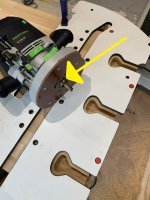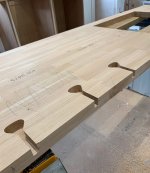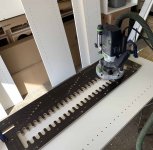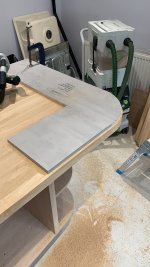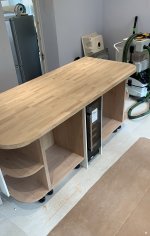woodbutcherbower
Member
One additional post for the OP's benefit regarding the use of copy rings = what they are, and what they're used for. Here's my OF2200 being used with a copy ring (usually known as a 'guide bush' in the UK) to rout butterfly bolt slots on the underside of an oak kitchen worktop. The ring's the silver component highlighted, and it works by pressing against the sides of a routing template (in this case a commercially-bought Unika one for worktop joints), guiding the router around its shape;
[attachimg=1]
[attachimg=2]
Here's another application - this time using another commercial jig (Sautershop) to rout many hundreds of super-clean 5mm shelf pin holes in the vertical sides of a 8-metre long cabinet run I was building for a customer;
[attachimg=3]
Templates can also be home-made. Here's one I knocked up using a scrap panel to rout curves on the ends of a kitchen island - (the same kitchen job as the first two pictures above, actually), You'll notice that the template is inset from the edge of the workpiece - this is to accommodate the distance between the guiding edge of the ring, and the cutting edge of the bit (see the first pic again to see what I mean - the router bit is cutting a narrower shape than the shape of the template itself). In this 'cutting a curve' case - the position of the template adjusted so that the bit is just 'kissing' the workpiece as you start to make the cut from the leading (straight) edge of the template.
[attachimg=4]
[attachimg=5]
I hope the above pics clarify things for you [smile]
Kevin
[attachimg=1]
[attachimg=2]
Here's another application - this time using another commercial jig (Sautershop) to rout many hundreds of super-clean 5mm shelf pin holes in the vertical sides of a 8-metre long cabinet run I was building for a customer;
[attachimg=3]
Templates can also be home-made. Here's one I knocked up using a scrap panel to rout curves on the ends of a kitchen island - (the same kitchen job as the first two pictures above, actually), You'll notice that the template is inset from the edge of the workpiece - this is to accommodate the distance between the guiding edge of the ring, and the cutting edge of the bit (see the first pic again to see what I mean - the router bit is cutting a narrower shape than the shape of the template itself). In this 'cutting a curve' case - the position of the template adjusted so that the bit is just 'kissing' the workpiece as you start to make the cut from the leading (straight) edge of the template.
[attachimg=4]
[attachimg=5]
I hope the above pics clarify things for you [smile]
Kevin

